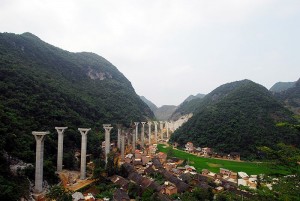The blog polis recently discussed the Chinese interstate expressway system with some excellent images and maps. The system recently overtook the U.S. interstate system as the largest national intercity highway system in the world, and is still growing. Often it is discussed the pace at which the Chinese have developed their infrastructure, but what is most impressive about the Chinese interstates is the manner in which they have been constructed.
As seen in the image below, the Chinese construction technique involves bridging valleys and tunneling through hills in order to achieve straight, flat roadways that are not bounded by the topography surrounding them. Compare this to the U.S. interstate system which winds up and downs mountains, tunnels only when necessary, and winds along twisty rivers.
We often praise the U.S. interstate system’s variation as it crosses different environments, while still maintaining consistent cross-sectional standards. This vertical and horizontal variation (hills and curves) is often described to be useful in keeping drivers alert – long straight sections often can cause a driver to zone out. These twists and turns also keep driving speeds in check, forcing even speeding drivers to slow down periodically. The Chinese system does not appear at first glance to have these inherent protections.
China, like the U.S., is fortunate to have a wide range of geographies within its borders. Now they have become more accessible to car owners and bus travelers through the expansion of intercity highways. It will interesting to see how these roads affect the Chinese economy and the development patterns of their cities, suburbs, and rural areas. Will automobile ownership skyrocket now that traveling by car is an option? How will they learn from the American experience and adjust to their needs? Clearly straighter, flatter, and faster was one decision they made, and hopefully one that doesn’t lead to higher fatality rates.
Either way, the U.S. is no longer the poster child for great highways. In the future, countries will be visiting China to find best practices of highway construction.
(Click the link at the top to see more great photos!!!)

